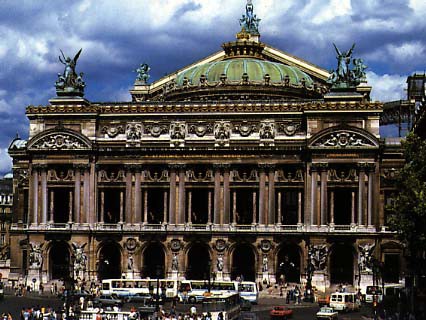On 29th September, 1860, Napoleon III ordered the construction of a new opera house to replace the one in rue Le Peletier, a temporary building both too narrow and situated in a congested area of Paris. A contest in which 171 applicants competed was launched in December. It was won by a young architect still unknown at the time named Charles Garnier. For fourteen years he devoted himself almost every day to the prestigious building site. The front was unveiled on 15th August, 1867, but the opera-house was only officially opened in 1875, after the fall of the Empire.
With this building, which made him famous, Garnier in effect also invented the architectural style of the Second Empire. When Empress Eugénie, puzzled by the building's lack of unity, asked him: “What is this style? This is no style, it is not Greek or Louis XVI”, the architect answered: “No, those styles are all outdated, this is Napoleon III”. The building, in the eclecticism and the exuberance of its decoration, is today seen as one of the symbols of the Imperial regime.
The opera house, with its the baroque curves, ornamental profusion, and polychromatic abundance contrasts strongly with, but nevertheless sits well in, the regularity and the solemn austerity of the architecture of Haussmann's new Paris. Garnier's plan is a masterpiece of functionalism and the building is exceptionally 'readable' from the exterior, with the vestibule surmounted by the foyer and served by the grand staircase, the auditorium, the stage extending from the dance foyer, and the section reserved for the management.
The facade, a baroque synthesis of various styles, is punctuated by Corinthian columns in stone from Ravières and topped by an attic storey decorated with classical masks by Klagmann. On the ground floor, a series of sculptures surround the doorways. “La Musique” by Guillaume, “La Poésie lyrique” by Jouffroy and “La Drame lyrique” by Perraud appear particularly academic compared with “La Danse” by Carpeaux. The dome (which corresponds to the cupola above the auditorium) and the triangular pediment (set above the stage) are topped by a work by Millet “Apollo with his lyre between Poetry and Music”.
Inside the building, the vestibule leads to the magnificent main staircase, a masterpiece of marble, porphyry and onyx lit with candelabra by Carrier-Belleuse. The main foyer is decorated with allegorical paintings by Baudry. The auditorium, in crimson and gold, comprises five storeys of boxes, and eight enormous columns support the dome. The former ceiling by Lenepveu was covered in 1964 by a new one painted by Chagall.
Garnier Opera House


